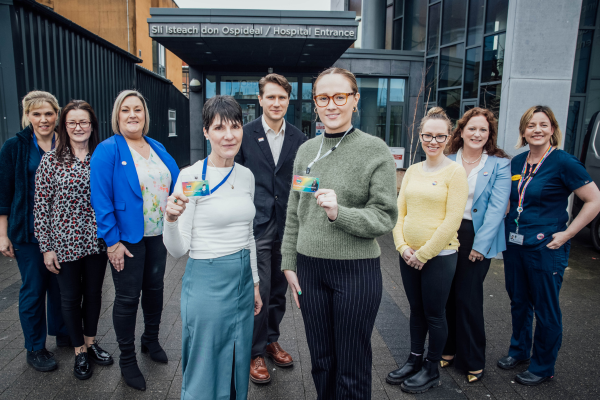Rainbow Badge initiative brings greater inclusion to the Children’s Ark at University Hospital Limerick

Tuesday, February 20, 2024: Staff in the Children’s Ark at University Hospital Limerick are promoting a culture of inclusivity by wearing the HSE Rainbow Badge.
The Rainbow Badge is a simple visual symbol identifying its wearer as someone an LGBTQI+ person can feel comfortable talking to about issues relating to sexuality and gender identity. It shows that the wearer is there to listen without judgement and signpost to further supports if needed. The Children’s Ark joins healthcare facilities across the country by taking part in this initiative.
Staff in the Children’s Ark wearing this badge are signalling to the young people in the service that they are open to having conversations about sexuality and gender identity. The launch of the Rainbow Badge initiative has been marked by an event in the CERC at University Hospital Limerick.
Professor Clodagh O’Gorman, Consultant General Paediatrician at UHL and Chairperson of Paediatrics at the University of Limerick explained why the initiative is important:
“Young people who identify as LGBTQI+ experience additional emotional and psychological stresses when compared to non LGBTQI+ youth. Many people still feel afraid to disclose their sexual or gender identity - being unable to do so often increases their risk of physical and mental health problems. At the Children’s Ark, we want to provide a safe space where the young people using our service feel comfortable discussing any issues relating to their sexuality.
The Children’s Ark is the first service at UL Hospitals Group to take part in the HSE Rainbow Badge initiative, however, it is anticipated that this initiative will be rolled out to services across entire group.”
The HSE provides education and training for all staff who want to take part in this initiative. When staff members sign up to wear the badge, they acknowledge why the project is needed and commit to providing an environment that is open, tolerant and inclusive. The aim of this initiative is to actively break down barriers which LGBTQI+ people may face when accessing healthcare.
Speaking at the launch of the Rainbow Badge initiative at the Children’s Ark, Ms Verena Tarpey, CEO of GOSHH (Gender, Orientation, Sexual Health, HIV) said:
“When we think of a young person presenting to the hospital, they may already be overwhelmed with anxiety about their illness. The hospital experience may be less stressful for young people who identify as LGBTQI+ if they can visibly see that they have allies in the staff members who are wearing the badge. The research in Ireland is clear that young people who identify as LGBTQI+ face additional stress. For example, 75% of Irish LGBTQI+ individuals believe that healthcare providers lack knowledge and sensitivity around LGBTQI+ issues. The Rainbow Badge may help change this perception.
In addition, I’m delighted that the team in the Children’s Ark are taking part in the Rainbow Badge initiative to provide a service that is open, inclusive and free from judgement for patients who may need their support.”
Dr Dani Hall, Consultant in Paediatric Emergency Medicine at Children’s Health Ireland (CHI) who launched the Rainbow Badge at CHI spoke about the positive impact that the badge has had there:
“We’ve surveyed our staff at CHI on their experiences of wearing the HSE Rainbow Badge. The responses have been so positive, both in terms of interactions with other staff, and with young people and their families. There’s an overwhelming feeling of pride: pride in taking part in the initiative, the message the badge sends to LGBTQI+ staff and patients, and pride in representing the community in healthcare. It’s also described as a symbol of safety and inclusion for patients and their families. But more than this, staff members who identify as LGBTQI+ say they feel accepted by other staff members when they see them wearing the badge. Our next plan is to look at the impact the badge has had on young people. These are only small steps towards bridging the gap between LGBTQI+ young people and healthcare but they’re a good start.”

